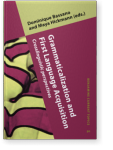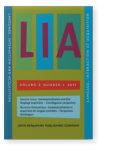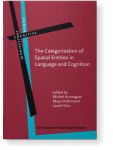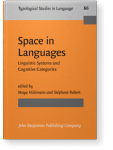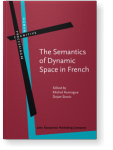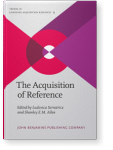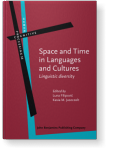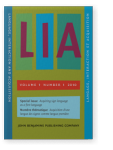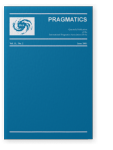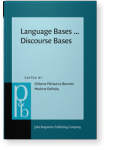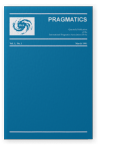Maya Hickmann †
List of John Benjamins publications for which Maya Hickmann † plays a role.
Journal
Sources of Variation in First Language Acquisition: Languages, contexts, and learners
Edited by Maya Hickmann †, Edy Veneziano and Harriet Jisa
[Trends in Language Acquisition Research, 22] 2018. x, 444 pp.
Subjects Language acquisition | Psycholinguistics | Theoretical linguistics
Grammaticalization and First Language Acquisition: Crosslinguistic perspectives
Edited by Dominique Bassano-Bonhommo and Maya Hickmann †
[Benjamins Current Topics, 50] 2013. v, 187 pp.
Subjects Language acquisition | Syntax | Theoretical linguistics
Grammaticalization and first language acquisition – Crosslinguistic perspectives/Grammaticalisation et acquisition des langues premières - Perspectives interlangues
Edited by Dominique Bassano-Bonhommo and Maya Hickmann †
Special issue of Language, Interaction and Acquisition 2:1 (2011) v, 184 pp.
Subjects Cognition and language | Language acquisition | Multilingualism
Language Acquisition across Linguistic and Cognitive Systems
Edited by Michèle Kail and Maya Hickmann †
[Language Acquisition and Language Disorders, 52] 2010. vii, 330 pp.
Subjects Cognition and language | Language acquisition | Multilingualism | Psycholinguistics | Theoretical linguistics
The Categorization of Spatial Entities in Language and Cognition
Edited by Michel Aurnague, Maya Hickmann † and Laure Vieu
[Human Cognitive Processing, 20] 2007. viii, 371 pp.
Subjects Cognition and language | Semantics | Theoretical linguistics
Space in Languages: Linguistic Systems and Cognitive Categories
Edited by Maya Hickmann † and Stéphane Robert
[Typological Studies in Language, 66] 2006. x, 361 pp.
Subjects Cognition and language | Semantics | Typology
2019 Casting an eye on motion events: Eye tracking and its implications for linguistic typology The Semantics of Dynamic Space in French: Descriptive, experimental and formal studies on motion expression, Aurnague, Michel and Dejan Stosic (eds.), pp. 249–288 | Chapter
In the last few decades there have been several attempts to connect language use with cognitive mechanisms underlying event representation. This language-thought interface is difficult to capture and highly debated. This chapter provides an overview of empirical and experimental studies relevant to… read more
2018 L’expression des procès spatiaux causatifs chez les apprenants francophones du chinois: Pousser ou entrer ? Language, Interaction and Acquisition 9:2, pp. 256–292 | Article
Cette recherche, située dans le cadre proposé par Talmy (1985, 1991, 2000), analyse la façon dont des apprenants francophones du chinois langue étrangère (un groupe de niveau intermédiaire et un groupe de niveau avancé) expriment les procès spatiaux causatifs, en comparaison avec des locuteurs… read more
2018 Introduction. What can variation tell us about first language acquisition? Sources of Variation in First Language Acquisition: Languages, contexts, and learners, Hickmann, Maya †, Edy Veneziano and Harriet Jisa (eds.), pp. 1–24 | Chapter
After years of research focusing on universal regularities in child language, the study of variation has enriched our understanding of language development. Variation stems from exogenous and endogenous factors that can all influence the development of communicative capacities. This volume focuses… read more
2018 Chapter 17. Motion expression in children’s acquisition of French Sign Language Sources of Variation in First Language Acquisition: Languages, contexts, and learners, Hickmann, Maya †, Edy Veneziano and Harriet Jisa (eds.), pp. 365–390 | Chapter
Much research has examined the development of motion expression, but little is known about this domain in sign language. This study examines how signers (Deaf children aged 5–10 and adults) of French Sign Language (LSF) described clips showing voluntary motion events with variable Paths and Manners. read more
2017 Chapter 2. Expressing and categorizing motion in French and English: Verbal and non-verbal cognition across languages Motion and Space across Languages: Theory and applications, Ibarretxe-Antuñano, Iraide (ed.), pp. 61–94 | Chapter
Language-specific properties influence motion expression (Slobin 2004; Talmy 2000), but it is still debated whether they also influence non-verbal spatial cognition. We compare how English and French speakers perform three tasks involving motion events: non-verbal categorization based on cartoons… read more
2015 From early to late mastery of reference: Multifunctionality and linguistic diversity The Acquisition of Reference, Serratrice, Ludovica and Shanley E.M. Allen (eds.), pp. 181–211 | Article
Developmental studies report either early or late mastery of reference during first language acquisition. This overview focuses on two dimensions that may account for this gap: the multifunctional nature of referring expressions that simultaneously contribute to linguistic organization at sentence… read more
2013 Grammaticalization and first language acquisition: Crosslinguistic perspectives Grammaticalization and First Language Acquisition: Crosslinguistic perspectives, Bassano-Bonhommo, Dominique and Maya Hickmann † (eds.), pp. 1–12 | Article
2013 Developmental perspectives on the expression of motion in speech and gesture: A comparison of French and English Grammaticalization and First Language Acquisition: Crosslinguistic perspectives, Bassano-Bonhommo, Dominique and Maya Hickmann † (eds.), pp. 129–155 | Article
Recent research shows that adult speakers of verb- vs. satellite-framed languages (Talmy, 2000) express motion events in language-specific ways in speech (Slobin 1996, 2004) and co-verbal gestures (Duncan 2005; Kita & Özyurek 2003; McNeill 1992). Although such findings suggest cross-linguistic… read more
2012 12. Caused motion events across languages and learner types: A comparison of bilingual first and adult second language acquisition Space and Time in Languages and Cultures: Linguistic diversity, Filipović, Luna and Katarzyna M. Jaszczolt (eds.), pp. 263–288 | Article
The present chapter shares the interest of preceding contributions in the consequences of cross-linguistic diversity for language acquisition. We explore the implications of Talmy’s motion event typology (see also Luk and Vidaković, this volume) for bilingual first and adult second language… read more
2011 Grammaticalisation et acquisition des langues premières: Perspectives interlangues Grammaticalization and first language acquisition – Crosslinguistic perspectives/Grammaticalisation et acquisition des langues premières - Perspectives interlangues, Bassano-Bonhommo, Dominique and Maya Hickmann † (eds.), pp. 1–11 | Article
2011 Developmental perspectives on the expression of motion in speech and gesture: A comparison of French and English Grammaticalization and first language acquisition – Crosslinguistic perspectives/Grammaticalisation et acquisition des langues premières - Perspectives interlangues, Bassano-Bonhommo, Dominique and Maya Hickmann † (eds.), pp. 129–156 | Article
Recent research shows that adult speakers of verb- vs. satellite-framed languages (Talmy, 2000) express motion events in language-specific ways in speech (Slobin 1996, 2004) and co-verbal gestures (Duncan 2005; Kita & Özyurek 2003; McNeill 1992). Although such findings suggest cross-linguistic… read more
2010 Chapter 7. Linguistic relativity in first language acquisition: Spatial language and cognition Language Acquisition across Linguistic and Cognitive Systems, Kail, Michèle and Maya Hickmann † (eds.), pp. 125–146 | Article
The relationship between language and cognition is perhaps one of the oldest questions in the history of social and cognitive sciences. This question is presently at the center of lively debates in light of a growing number of cross-linguistic studies suggesting that language-specific factors could… read more
2010 Preface Acquiring Sign Language as a First Language / Acquisition d’une langue des signes comme langue première, Sallandre, Marie-Anne and Marion Blondel (eds.), pp. 1–2 | Miscellaneous
2010 Introduction. New perspectives in the study of first
and second language acquisition: Linguistic and cognitive constraints Language Acquisition across Linguistic and Cognitive Systems, Kail, Michèle and Maya Hickmann † (eds.), pp. 1–14 | Article
2007 Introduction: Searching for the categorization of spatial entities in language and cognition The Categorization of Spatial Entities in Language and Cognition, Aurnague, Michel, Maya Hickmann † and Laure Vieu (eds.), pp. 1–32 | Article
2007 Static and dynamic location in French: Developmental and cross-linguistic perspectives The Categorization of Spatial Entities in Language and Cognition, Aurnague, Michel, Maya Hickmann † and Laure Vieu (eds.), pp. 205–231 | Article
Cross-linguistic research has renewed old questions concerning universal vs. language-specific determinants of child language. Our experiments show differences in how French vs. English speakers from three years on talk about static and dynamic spatial entities. In English frequent satellites… read more
2006 The relativity of motion in first language acquisition Space in Languages: Linguistic Systems and Cognitive Categories, Hickmann, Maya † and Stéphane Robert (eds.), pp. 281–308 | Article
2006 Introduction: Space, language, and cognition: Some new challenges Space in Languages: Linguistic Systems and Cognitive Categories, Hickmann, Maya † and Stéphane Robert (eds.), pp. 1–15 | Miscellaneous
2001 Language and cognition in development: Old questions, new directions Pragmatics 11:2, pp. 105–126 | Article
The relation between language and cognition in child development is one of the oldest and most debated questions, which has recently come back to the forefront of several disciplines in the social sciences. The overview below examines several universalistic vs. relativistic approaches to this… read more
1991 The Development of Discourse Cohesion: Some Functional and Cross-Linguistic Issues Language Bases ... Discourse Bases: Some aspects of contemporary French-language psycholinguistics research, Piéraut-Le Bonniec, Gilberte and Marlene Dolitsky (eds.), pp. 157–185 | Article
1991 Children's strategies when reporting appropriate and inappropriate speech events Pragmatics 1:1, pp. 27–70 | Article
This study examines the effects of utterance form and appropriateness on how children report conversations. Children between 7 and 9 years were asked to narrate filmed dialogues that contained two types of target utterances: (a) declaratives, interrogatives, or imperatives that were used… read more


